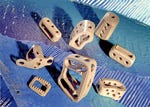September 6, 2001
A New Source for Implantable PEEK
Device OEMs take note: you may want to add a new name to your Rolodex under implantable materials. Invibio Inc. (Greenville, SC; www.invibio.com) chose the Medical Design and Manufacturing East show in New York to announce its official launch as the sole manufacturer and supplier of implantable PEEK.
|
Spinal cages made of an implantable grade of PEEK promote bone stimulus and fusion. |
A polyaryletherketone polymer, PEEK-Optima combines chemical and hydrolysis resistance, strength, and tribological properties with biocompatibility. Invibio currently has three grades available, which can be "custom tailored to meet specific applications and offer virtually unlimited design solutions," says company president Michael Callahan. Because the material can be extruded, molded, and machined, it offers device manufacturers broad design and production flexibility.
Invibio is wholly owned by UK-based Victrex plc, which previously offered the biocompatible material. According to Callahan, traditional business models do not necessarily apply to the medical implant market. Invibio was founded, he continues, to provide this market with a focused development, marketing, technology, and sales approach.
PEEK-Optima is manufactured under strict production guidelines, and has undergone extensive biocompatibility and biostability testing. ISO 10993 and USP Class VI test results are contained in a Device Master File at FDA. Suitable applications for the material include spine cages, bone screws and pins, hip implants, cardiopulmonary devices, and dental implantables.
Recent applications include synthetic finger-joint products manufactured by Switzerland-based Mathys Medical. The company had been using acetal, but it switched to PEEK-Optima because of its better radiation resistance and CT and MRI compatibility, according to Callahan. The material was also specified by French company Scient'x for the production of cervical and lumbar spinal fusion cages, where it replaced titanium. PEEK-Optima was deemed a superior material for these devices because its elasticity modulus closely resembles that of cortical bone, thus promoting bone stimulus and fusion.
Norbert Sparrow
You May Also Like



